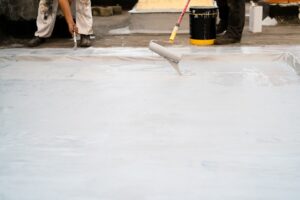Formerly, the adoption of flat roofing systems was largely confined to industrial facilities, with conventional gable, mansard, or hip roof types chosen for low-rise buildings. However, advancements in technology and improvements within the building components industry gave a boost to using horizontal roofing systems in residential housing development.
According to a report from Grand View Research, the global flat roofing market size was valued at USD 19.47 billion in 2020, and it is anticipated to expand at a compound annual growth rate (CAGR) of 2.5% from 2021 to 2028. As for today, flat roofing systems are on the rise owing to their architectural modernism, energy efficiency, and ease of installation. Plus, the space provided by flat roofs can be utilized for creating rooftop gardens or terraces, making them a preferred choice for urban dwellers.
Read on to explore the fascinating and rapidly evolving world of flat roofing. With a surge in technological breakthroughs and an increased emphasis on sustainability, this sector is undergoing significant changes. Discover key trends and innovative practices that are redefining flat roofing.
Recent Advancements In Flat Roofing Materials – EPDM, TPO & PVC
Single-ply membrane roofing has emerged as an advanced solution for flat roof covering in both commercial and residential applications. These materials are not only simple to install but also offer flexibility and durability, becoming a cost-efficient solution for both homeowners and roofing pros. The most advanced types of single-ply membrane roofing materials are Thermoplastic Polyolefin (TPO), Polyvinyl Chloride (PVC) and Ethylene Propylene Diene Monomer (EPDM). They are durable and resilient, ensuring a tight seal, which is particularly crucial for flat roofing systems as they are more prone to water pooling and leakage.
In regards to installation, single-ply membrane roofing provides an innovative method that differs from traditional roofing. Unlike built-up roofs that require multiple layers and coating, a single-ply membrane can be installed in large sheets directly onto the roof surface, either mechanically attached or adhered using adhesive. This method optimizes installation time and eliminates the risk of blistering that can occur with built-up roofs.
Let us look closely at TPO, PVC and EPDM as the most widespread single-ply membrane options that stay at the forefront of modern flat roofing materials.
TPO
Thermoplastic polyolefin is a highly energy-efficient single-ply roofing membrane with strong reflective properties that reduce heat absorption and indoor cooling costs. Its unmatched flexibility and resistance to direct UV rays and algae make TPO a reliable low-slope roofing system. Flat roofing contractors often use TPO to roof newly-built homes as the flexibility of this material allows it to accommodate a building’s movement and settling without causing damage or cracking.
PVC
Polyvinyl Chloride roofing is a type of single-ply roofing system that offers ultimate weather resistance, insulation, and high performance against leaks. Plus, thanks to heat-welded seams, PVC is not vulnerable to high winds, fire, and standing water, serving for 20-30 years with proper maintenance. This light and flexible material is highly recommended for flat roofs with multiple projections and obstacles, as it easily stretches while still keeping a tight seal.
EPDM
Ethylene Propylene Diene Monomer is a single-ply membrane made from recycled rubber materials that makes it dense, flexible, and environment-friendly. EPDM has superior resistance to weathering and direct sun, serving for 30 or more years without showing significant signs of wear and tear. The high resilienсу level predominant to Ethylene Propylene Diene Monomer makes it easy to install and adapt to structural movements, further contributing to its cost-effectiveness.
Exploring Modern Techniques For Flat Roofing Systems – Cool, Green & Liquid-Applied Roofing
 Today’s construction industry is witnessing unprecedented advancements in designing and implementing flat roofing systems. Among these, cool, green, and liquid-applied roofing technologies are the flag-bearers of innovation, pushing the boundaries toward creating more sustainable and efficient buildings. These modern practices not only offer enhanced durability and cost-effectiveness but also address the pressing issue of reducing a carbon footprint.
Today’s construction industry is witnessing unprecedented advancements in designing and implementing flat roofing systems. Among these, cool, green, and liquid-applied roofing technologies are the flag-bearers of innovation, pushing the boundaries toward creating more sustainable and efficient buildings. These modern practices not only offer enhanced durability and cost-effectiveness but also address the pressing issue of reducing a carbon footprint.
Cool Roofing Technology For Flat Roofs
Cool roofing, a revolution in flat roofing systems, enhances solar reflectance and thermal emittance. Contrasting dark-roofed buildings that can reach staggering temperatures, cool roofs reduce heat transfer to a building, ensuring better energy efficiency and lower utility spending.
Green Roofing Technology For Flat Roofs
This progressive approach in flat roofing systems involving vegetation and a growing medium installed over a waterproofing membrane promotes sustainability and eco-friendliness. Green roofing improves air quality, enhances the building’s aesthetic appeal, and offers natural insulation.
Liquid-Applied Roofing Technology For Flat Roofs
This innovative technology for flat roofing systems, characterized by applying a monolithic, fully-bonded, liquid-based coating, ensures a dense waterproof membrane resistant to damage and the elements. The thick and resilient membrane can stretch and return to its original shape without damage, which is especially important for flat roofs with complex structures. Such a unique blend of adaptability, durability, and effective waterproofing makes liquid roofing an increasingly popular choice in modern construction.
The Bottom Line
In conclusion, as technology evolves, flat roofing systems are becoming more efficient and favorable. The emergence of new materials like TPO, PVC, and EPDM, as well as cool, green, and liquid-applied roofing technologies, have revolutionized the industry, offering solutions that are durable, cost-effective, and eco-friendly. Moreover, these advancements have made it possible to effectively overcome the challenges associated with flat roofs, such as water pooling and leakage. The fusion of aesthetics, functionality, and sustainability offered by these modern techniques in flat roofing is indeed charting a new course for the construction industry.


